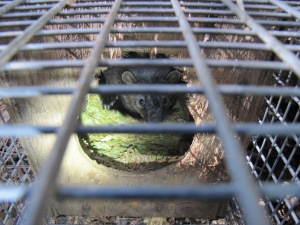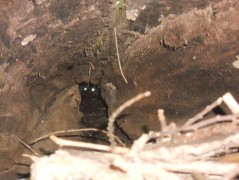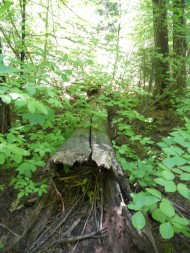Over the last few months, many of the female fishers on Stirling have been busy raising their litters, and as such, we have been busy trying to keep track of them. We see females start to den from mid-March to early-April, and try to document how many kits they end up having, along with what kind of structures they are using. When we find a den, we put a few motion sensor cameras around it with the hope of capturing photos of kits when they move to a different den. In addition to seeing kits, we sometimes get photos of other cool things like males visiting to breed, different prey being brought back to the dens, and visitation by predators.
Documenting kits is often a lesson in frustration and patience. Fishers usually have multiple ways to get in/out of their dens, and many do a very good job of evading our cameras. However, over the course of the summer, our persistence eventually paid off and we were able to document quite a number of kits from most of the known denning females!
From March 18th – July 15th, we documented 57 dens from 17 females. We were able to confirm kits from 15 of 17 fishers. Remote cameras placed around the dens picked up a minimum of 30 kits, for an average of 2 kits per female. Like in previous years, the number of kits ranged from 1-3 per female. The known rate of denning this year was 89%.
The length of stay in any one den varied greatly between individuals and dens. We saw the first female move from a natal den on March 27th. The last holdout stayed in her natal den until May 30th. In contrast, one female had used 6 different dens before May 30th.
We often see mating behavior from late-March to early-April around dens, and this year was no exception. Males visited the majority of early den sites, and cameras picked up breeding on multiple occasions. In once instance, mating occurred over a 2 1/2 hour period!
Raising kits increases the energetic demand of fishers, who now have multiple mouths to feed. Not surprisingly, we often see an increase in mortalities during the summer months from females raising young. This summer we have had 3 females die who we knew were denning. It is always sad when a fisher dies, and knowing that their kits will not make it is especially hard. I usually reconcile this with the knowledge that we document a far greater number of kits than the number of fishers that die, and assuming many of these youngsters make it to adulthood, they should replace those we lost.
By this point in the summer, the juveniles are getting pretty big. It won’t be too much longer before they disperse and try and make a living on their own. Included are some pictures from this years’ denning. I have tried to put them chronologically, so you can see the changes in kit size as the summer progresses.

























